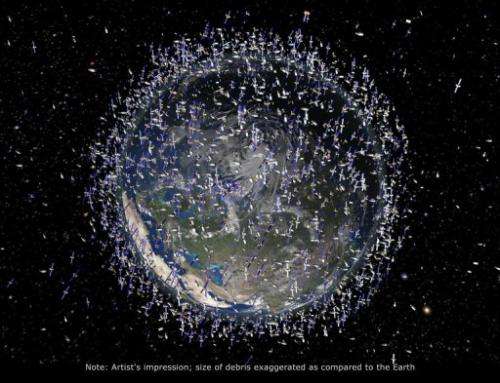Space debris problem now urgent, scientists say

Governments must start working urgently to remove orbital debris, which could become a catastrophic problem for satellites a few decades from now, a space science conference heard on Thursday.
Since 1978, the total of junk items whizzing around the planet has tripled, said Heiner Klinkrad, head of the European Space Agency's Space Debris Office.
"There is a wide and strong expert consensus on the pressing need to act now to begin debris removal activities," he said in an ESA press release at the end of a four-day conference in Darmstadt, Germany.
"Our understanding of the growing space debris problem can be compared with our understanding of the need to address Earth's changing climate some 20 years ago," he said.
According to a count by ESA and NASA, there are more than 23,000 items in orbit that are bigger than 10 centimetres (four inches) across, and hundreds of thousands of items between one and 10 cms (0.4 to four inches) across.
Even though these items are relatively small and there is a lot of room in orbit, any collision could be calamitous because of the high level of kinetic energy.
Debris travels on average at 25,000 kilometres (15,600 miles) per hour, so even an object of small mass has the potential to cripple a satellite or punch a hole in the International Space Station (ISS).
The junk results mainly from disused rocket stages, failed launches and abandoned or broken-down satellites, the result of 55 years of space exploration.
These large objects eventually collide, creating more debris which in turn smashes together—a dangerous cascade cycle known as the Kessler Syndrome.
A major debris field was caused in 2007 when China tested an anti-satellite weapon on an old weather satellite, triggering an international outcry.
At the current rate of rocket launches, the collision risk could eventually rise by a factor of 25.
The Darmstadt conference brought together more than 350 experts from Europe, North America and Asia, including specialists from national space agencies and industry.
They heard proposals aimed at removing the largest chunks of debris out of orbit at the rate of five to 10 items per year.
These pieces could be nudged into a death plunge in the atmosphere by netting or harpooning them from a robot vessel or bombarded by an ion cannon to deflect them onto a new course.
Another idea is to attach a "solar sail" to large items of debris that would be gently driven by the solar wind—the particles blasted out by the Sun.
(c) 2013 AFP


















